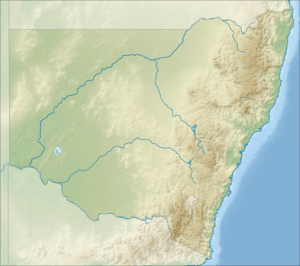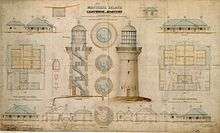Montague Island Light
 Montague Island Light | |
 New South Wales | |
| Location |
Montague Island New South Wales Australia |
|---|---|
| Coordinates | 36°15′7.15″S 150°13′35.19″E / 36.2519861°S 150.2264417°ECoordinates: 36°15′7.15″S 150°13′35.19″E / 36.2519861°S 150.2264417°E |
| Year first constructed | 1881 |
| Automated | 1986 |
| Construction | granite tower |
| Tower shape | cylindrical tower with balcony and lantern |
| Markings / pattern | gray tower, white lantern |
| Height | 69 feet (21 m) |
| Focal height | 262 feet (80 m) |
| Original lens | 1st order Fresnel lens |
| Intensity | 120,000 cd |
| Range | 20 nautical miles (37 km; 23 mi) |
| Characteristic | Fl W 15s.[1] |
| Admiralty number | K2576 |
| NGA number | 111-6568 |
| ARLHS number | AUS-110 |
| Managing agent | Australian Maritime Safety Authority |
Montague Island Light is an active lighthouse on Montague Island, an island 9 kilometres (5.6 mi) offshore from Narooma on the south coast of New South Wales, Australia. The lighthouse is located at the highest point of the island.
History

The building of a "First Order Fixed and Flashing Light" was first decided 1873, with finance approved in 1877 and tenders called in October 1878. The lighthouse is one of many designed by James Barnet along the New South Wales coast.
The original constructor did not complete the construction due to finance problems. Problems started with an unauthorized blasting by the contractor that damaged the granite boulder selected as base. As a result, the tower was repositioned several feet. After more difficulties and delay the contractor gave up the contract. In 1880 a temporary light was set up, and a new tender was given, with construction completing a year later in October 1881, 4 months early. The official lighting was on 1 November 1881. The light characteristic was a steady flare for 30s, then an eclipse for 13s, then a flash for 4s, then another eclipse of 13s, a total cycle of one minute. The power source was oil, though some reports say kerosene, and the light intensity was 45,000 cd.
The light was upgraded once in 1910 to an intensity of 250,000 cd, with the installation of a Douglas incandescent kerosene burner, and a second time in 1923 to an intensity of 357,000 cd.
A Mercury bearings were installed in 1926 and the characteristic changed to a flash every 7.5s
In 1969 the light was electrified, with a diesel generator supplying the power, and the light intensity was raised to 1,000,000 cd. Four panels from Green Cape Lighthouse were fitted, changing the characteristic to one flash every 4.5s.
Original lens – current display
The original lens was last used on November 9, 1986. It was replaced with an array of lightweight solar powered 12 V quartz halogen lamps radiating two beams of 120,000 cd, and a total power consumption of 75 W.[2]
The original Fresnel lens was packed prism by prism in individual cases surrounded by expanding foam and sent to Sydney for storage. After public volunteering and fund collection for constructing a proper display, the lens was officially transferred back on 10 August 1990 to be displayed in the Lighthouse Museum at Narooma (36°12′59″S 150°07′39″E / 36.2165°S 150.1275°E), where the lens and mechanism are currently displayed in a 5 metres (16 ft) tower. Visitors can coin-operate the display.
Light keepers
| Name | Rank | Years |
|---|---|---|
| John Burgess | Head | 1881–1898 |
| Charles Townsend | Assistant | 1894 |
| Jock Cameron | Assistant | 1920–1923 |
| Head | 1933–1935 | |
| Tom Paddon | Assistant | 1932–1934 |
| Albert Cottee | ?? | 1942 – ? |
| Jack Carmody | Head | 1960–1967 |
| Bruce Conley | Head | 1973–1980 |
| John Short | Head | ? – 1986 |
Construction
The tower is constructed from interlocking granite blocks which were quarried on the island. It is fitted with a bronze handrail.
There are at least two single-storey lighthouse keeper's houses.
Site operation
The light is operated by the Australian Maritime Safety Authority. The site is managed by the Department of Environment, Climate Change and Water as part of the Montague Island Nature Reserve.
Visiting
Access to the island is restricted. Access is available only through guided tours from Narooma, and reservations is required. Overnight stays for up to 11 people are available at the keeper's house.[3]
See also
Notes
- ↑ According to List of Lights. The Lighthouse Directory and "Lighthouses of Australia" list 7.5s
- ↑ According to "SeaSide Lights". 35 W according to "Lighthouses of Australia".
- ↑ "Montague Island Tours NSW, information, bookings". montagueisland.com.au. Retrieved 1 September 2010.
References
| Wikimedia Commons has media related to Montague Island Light. |
- List of Lights, Pub. 111, The West Coasts of North and South America (Excluding Continental U.S.A. and Hawaii), Australia, Tasmania, New Zealand, and the Islands of the North and South Pacific Oceans (PDF). List of Lights. United States National Geospatial-Intelligence Agency. 2009. p. 133.
- Rowlett, Russ. "Lighthouses of Australia: New South Wales". The Lighthouse Directory. University of North Carolina at Chapel Hill. Retrieved 2010-08-29.
- "The Montague Island Lighthouse". Lighthouses of New South Wales. Lighthouses of Australia Inc.
- Searle, Garry. "Montague Island". Lighthouses of New South Wales. SeaSide Lights.
